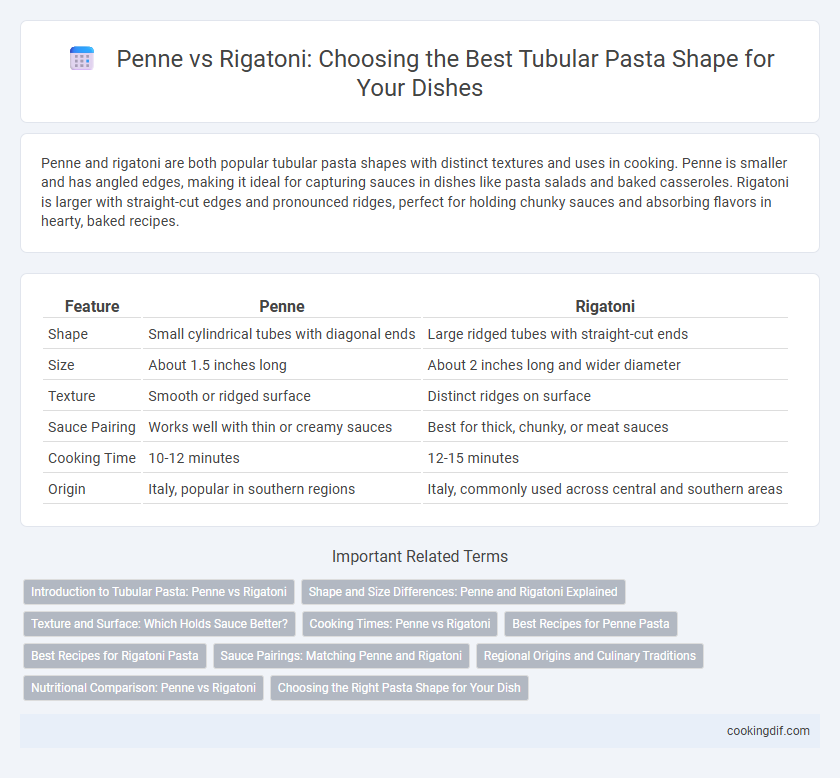Penne and rigatoni are both popular tubular pasta shapes with distinct textures and uses in cooking. Penne is smaller and has angled edges, making it ideal for capturing sauces in dishes like pasta salads and baked casseroles. Rigatoni is larger with straight-cut edges and pronounced ridges, perfect for holding chunky sauces and absorbing flavors in hearty, baked recipes.
Table of Comparison
| Feature | Penne | Rigatoni |
|---|---|---|
| Shape | Small cylindrical tubes with diagonal ends | Large ridged tubes with straight-cut ends |
| Size | About 1.5 inches long | About 2 inches long and wider diameter |
| Texture | Smooth or ridged surface | Distinct ridges on surface |
| Sauce Pairing | Works well with thin or creamy sauces | Best for thick, chunky, or meat sauces |
| Cooking Time | 10-12 minutes | 12-15 minutes |
| Origin | Italy, popular in southern regions | Italy, commonly used across central and southern areas |
Introduction to Tubular Pasta: Penne vs Rigatoni
Penne and rigatoni are two popular tubular pasta shapes, each distinguished by size and texture. Penne is smaller with diagonal cuts, designed to hold light sauces in its ridges, while rigatoni is larger, ridged, and straight-cut, ideal for chunkier, hearty sauces that cling to its surface. Understanding these differences enhances pairing choices for dishes, maximizing flavor absorption and texture harmony.
Shape and Size Differences: Penne and Rigatoni Explained
Penne pasta features smooth or ridged cylindrical tubes with diagonally cut ends, measuring about 1.5 to 2.5 inches in length and 0.3 inch in diameter, ideal for holding lighter sauces due to its narrower shape. Rigatoni is larger, with ridged tubes approximately 1.5 to 2 inches long and 0.5 to 0.75 inch wide, featuring straight-cut ends that create a more substantial bite and better sauce retention. The size and end shape differences influence texture and sauce adhesion, making penne suited for delicate meals and rigatoni perfect for hearty, thick sauces.
Texture and Surface: Which Holds Sauce Better?
Penne features ridged surfaces and a slightly smaller diameter, allowing sauces to cling effectively both inside and out, providing a balanced texture in each bite. Rigatoni boasts larger tubes with pronounced ridges and a rougher texture, which excel at trapping chunky sauces and hearty ingredients for a robust flavor experience. The surface texture and size differences between penne and rigatoni directly impact their sauce-holding capabilities, with rigatoni better suited for thick, meaty sauces and penne ideal for smoother, creamier ones.
Cooking Times: Penne vs Rigatoni
Penne typically cooks faster than rigatoni due to its smaller size and thinner walls, with average cooking times ranging from 9 to 12 minutes compared to rigatoni's 12 to 15 minutes. The denser, thicker tubes of rigatoni require longer boiling to achieve the desired al dente texture, making precise timing crucial to avoid undercooking or mushiness. Pasta brands may vary, so checking package instructions for penne and rigatoni is essential for optimal cooking results.
Best Recipes for Penne Pasta
Penne pasta, characterized by its smooth or ridged cylindrical shape with angled ends, excels in recipes that require holding onto rich and chunky sauces, such as penne arrabbiata or penne alla vodka. Its smaller diameter compared to rigatoni allows for quicker cooking times and better integration in baked dishes like penne al forno. Penne's versatility and texture make it ideal for both cold pasta salads and warm, hearty meals where sauce adherence is crucial.
Best Recipes for Rigatoni Pasta
Rigatoni's ridged surface and large diameter make it ideal for hearty sauces like Bolognese, baked dishes, and creamy cheese sauces that cling well to the pasta. Unlike penne, which is smaller and often diagonally cut, rigatoni's robust shape holds up in baked casseroles and chunky meat sauces, enhancing each bite with rich flavor. Classic recipes such as Rigatoni alla Vodka, Rigatoni al Forno, and spicy Rigatoni Arrabbiata highlight its versatility and ability to absorb bold, savory ingredients.
Sauce Pairings: Matching Penne and Rigatoni
Penne's narrow, smooth tubes hold lighter sauces like marinara or pesto, allowing flavors to coat each piece evenly, while rigatoni's larger, ridged shape captures thicker, hearty sauces such as Bolognese or creamy Alfredo. The ridges on rigatoni enhance sauce adhesion, making it ideal for chunky vegetable or meat-based sauces. Penne suits both short and long cooking times, complementing delicate sauces without overpowering, whereas rigatoni provides a robust texture that stands up to richer, slower-cooked preparations.
Regional Origins and Culinary Traditions
Penne originates from the Campania region, particularly Naples, and is characterized by its diagonal cut and smooth or ridged surface, making it ideal for lighter sauces like arrabbiata. Rigatoni, with its large, ridged tubes and straight-cut ends, hails from Central and Southern Italy, especially Lazio and Sicily, where it is traditionally paired with hearty meat sauces and baked dishes. Culinary traditions favor penne for quick sautes and cold pasta salads, while rigatoni's robust texture holds up well in slow-cooked ragus and baked casseroles.
Nutritional Comparison: Penne vs Rigatoni
Penne and rigatoni, both tubular pasta shapes made from durum wheat semolina, offer similar caloric content, with penne providing approximately 200 calories per 56-gram serving and rigatoni slightly higher at 210 calories for the same portion. Nutritionally, penne contains about 7 grams of protein and 42 grams of carbohydrates per serving, while rigatoni provides 8 grams of protein and 43 grams of carbohydrates, making rigatoni marginally richer in macronutrients. Both pastas are low in fat and fiber, but choosing whole grain versions enhances fiber content and micronutrient density for improved digestive health and sustained energy release.
Choosing the Right Pasta Shape for Your Dish
Penne and rigatoni differ in size, texture, and groove patterns, influencing sauce retention and mouthfeel. Penne's smaller, diagonally cut tubes hold lighter, cream-based sauces well, while rigatoni's larger diameter and ridges capture chunky, meaty sauces more effectively. Selecting the right tubular pasta shape enhances flavor absorption and overall dish balance.
penne vs rigatoni for tubular pasta shapes Infographic

 cookingdif.com
cookingdif.com